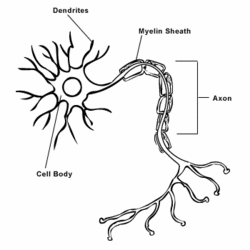Neuron: Difference between revisions
imported>Rahmat Muhammad mNo edit summary |
imported>Rahmat Muhammad No edit summary |
||
| Line 2: | Line 2: | ||
[[Image:Neuron diagram with labels.gif|right|thumb|250px|{{#ifexist:Template:Neuron diagram with labels.gif/credit|{{Neuron diagram with labels.gif/credit}}<br/>|}}Labeled diagram of a neuron.]] | [[Image:Neuron diagram with labels.gif|right|thumb|250px|{{#ifexist:Template:Neuron diagram with labels.gif/credit|{{Neuron diagram with labels.gif/credit}}<br/>|}}Labeled diagram of a neuron.]] | ||
<br/> | <br/> | ||
In [[biology]], a '''neuron''' is a [[cell]] that specializes in information transfer, and the fundamental unit of the [[nervous system]].<ref>Zigmond M, et. al., eds. (1999) ''Fundamental Neuroscience'' ISBN 0127808701</ref> Neurons can initiate and transmit the electrical signals necessary for the proper function of most biological organisms. | In [[biology]], a '''neuron''' is a [[cell]] that specializes in information transfer, and the fundamental unit of the [[nervous system]].<ref>Zigmond M, et. al., eds. (1999) ''Fundamental Neuroscience'' ISBN 0127808701</ref> Neurons can initiate and transmit the electrical signals necessary for the proper function of most biological organisms. The unique structure of a neuron is optimized to allow it to transfer information intracellularly from one part of the cell to another and intercellularly between cells. The three structural elements unique to neurons are the [[axon]], which is used for intracellular information transfer, the [[dendrite]], which is the site often used to receive information from other neurons, and the [[synapse]], which allow them to transmit signals to other neurons in the organism.<ref>Purves D, et. al., eds. (1997) ''Neuroscience'' ISBN 0878937471</ref> Neurons also contain a cell body or [[soma]] which contains the [[cell nucleus]] and other [[organelle]]s which are required for normal cell functioning. | ||
==References== | ==References== | ||
<references/> | <references/> | ||
Revision as of 18:15, 10 January 2008
In biology, a neuron is a cell that specializes in information transfer, and the fundamental unit of the nervous system.[1] Neurons can initiate and transmit the electrical signals necessary for the proper function of most biological organisms. The unique structure of a neuron is optimized to allow it to transfer information intracellularly from one part of the cell to another and intercellularly between cells. The three structural elements unique to neurons are the axon, which is used for intracellular information transfer, the dendrite, which is the site often used to receive information from other neurons, and the synapse, which allow them to transmit signals to other neurons in the organism.[2] Neurons also contain a cell body or soma which contains the cell nucleus and other organelles which are required for normal cell functioning.
References
- ↑ Zigmond M, et. al., eds. (1999) Fundamental Neuroscience ISBN 0127808701
- ↑ Purves D, et. al., eds. (1997) Neuroscience ISBN 0878937471
